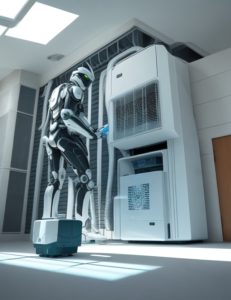Modern features & technologies to look for in modern air conditioning
 If your air conditioner is becoming old and not working as well as before, you are probably thinking about getting a new one soon. Most household systems in Jacksonville have a lifespan of 8 to 15 years, so it’s likely been a while since you last shopped for AC equipment. However, it’s important to note that things have evolved since then. Here are some new technology and key factors to consider when searching for an ac replacement.
If your air conditioner is becoming old and not working as well as before, you are probably thinking about getting a new one soon. Most household systems in Jacksonville have a lifespan of 8 to 15 years, so it’s likely been a while since you last shopped for AC equipment. However, it’s important to note that things have evolved since then. Here are some new technology and key factors to consider when searching for an ac replacement.
Advanced Air Conditioning Compressor Systems
Older air conditioning units typically operate at a single speed, running at full capacity. This can lead to frequent on-off cycles, especially when the temperature is slightly above the desired setting. Such frequent startups not only consume more electricity but also wear out the system components faster. Enter the variable-stage system, also known as VRF (Variable Refrigerant Flow). These systems adjust their capacity based on the current conditions, offering homeowners:
-
- Stable temperature maintenance
- Zoning capabilities for varied cooling needs
- Enhanced humidity management
- Reduced fan and compressor noise
- Savings on electricity bills
Solutions for Quieter AC Operation
Disturbed by the loud noise of your AC? Beyond the quieter variable-stage systems, there are innovative solutions to dampen the sound:
- Fiberglass insulation for ducts
- Quieter duct materials like flex duct
- Sound blankets and baffles
- Internal duct silencers
Versatile Heat Pumps For Heating and Cooling
Heat pumps, which can both heat and cool spaces, have been popular in the southern US for years.
Heat pumps are a good choice for Florida’s climate. They are an all-in-one HVAC system that can cool your home in the summer and heat it in the winter. They are the most energy-efficient heating option in Florida.
Ductless Mini Splits
For those in older buildings without duct infrastructure, mini-splits offer a modern solution. These systems, which don’t require ducts, consist of compact units installed in rooms. They’re subtle, don’t obstruct windows, and can be used to set different temperatures in different zones. Mini-splits are a popular choice for older buildings because they provide a modern and efficient solution for heating and cooling without the need for ductwork. They consist of two main components: an outdoor compressor unit and one or more indoor units installed in individual rooms.
One advantage of mini-splits is their compact size and sleek design. The indoor units are typically mounted high on the walls or installed recessed into the ceiling, making them unobtrusive and not obstructing windows or valuable wall space. This allows for a more seamless integration with the existing interior design of the building.
Another benefit is the ability to have different temperatures in different zones or rooms. Each indoor unit operates independently, meaning you can cool or heat individual rooms to different comfort levels based on specific needs. This level of customization offers greater control and energy efficiency, as you can avoid wasting energy on unoccupied or lesser-used areas.
Mini-splits also tend to be highly energy-efficient. Unlike traditional HVAC systems that experience energy loss through ductwork, mini-splits eliminate this problem by directly delivering conditioned air into each room. Additionally, they usually incorporate inverter technology, which allows the units to adjust their speed based on the cooling or heating requirements. This results in reduced energy consumption and lower utility bills.
Installation of mini-splits in older buildings is generally easier and less disruptive than retrofitting a ducted system. It often involves minimal construction work and can be completed relatively quickly. This makes mini-splits a convenient option for those who prefer to maintain the integrity of their historic or older buildings while still enjoying modern comforts.
In conclusion, mini-splits provide a modern solution for heating and cooling in older buildings without duct infrastructure. Their compact size, inconspicuous installation, and ability to set different temperatures in different zones make them an attractive option. Additionally, their energy efficiency and ease of installation further contribute to their appeal.
Integrated Air Quality Solutions
With growing concerns about air quality due to events like the Canadian wildfires, integrated air purification systems for HVACs have become essential. These systems continuously filter the air, removing harmful contaminants using UV and other cutting-edge technologies. In addition to removing particles such as dust, pollen, and mold, integrated air purification systems for HVACs can also eliminate bacteria, viruses, and other microorganisms from the air. This helps create a healthier indoor environment and reduces the risk of respiratory issues and allergies.
UV technology is one of the key components of these systems. UV lamps installed within the HVAC system emit ultraviolet light, which kills or deactivates microorganisms that pass through the system. This technology effectively neutralizes harmful substances, making the air cleaner and safer to breathe.
Another technology commonly used in integrated air purification systems is activated carbon filtration. Activated carbon filters are designed to remove odors, chemicals, and volatile organic compounds (VOCs) from the air. These filters have a large surface area, which allows them to trap a wide range of pollutants and improve the overall air quality.
Some advanced air purification systems also incorporate ozone generators. Ozone is a highly reactive gas that can effectively eliminate odors and kill bacteria and viruses. However, it’s important to note that ozone can be harmful to humans if present in high concentrations, so these systems are designed to control and regulate ozone levels to ensure safe and efficient purification.
In terms of operation, these integrated systems work in conjunction with the HVAC system. The air purification components, such as the UV lamps and activated carbon filters, are integrated into the existing HVAC unit or ductwork. They operate continuously, ensuring that the air passing through the system is constantly being purified and cleaned.
With the increasing concerns about air quality and the rising prevalence of events like wildfires, integrated air purification systems for HVACs have become indispensable. These systems not only provide cleaner and healthier indoor air but also contribute to the overall comfort and well-being of building occupants.
Intelligent Thermostats
Manual thermostat adjustments are a thing of the past. Smart thermostats offer:
-
- Customizable temperature schedules
- Remote control via smartphones
- Hands-free temperature adjustments
- Energy savings by optimizing AC usage
Long-lasting Equipment
Homeowners seek durability in their HVAC systems. Modern air conditioning units are crafted to endure, especially the outdoor components. Look for features like rust-resistant bases, cabinets, and fasteners for prolonged lifespan.
The Future of Air Conditioning: 2023 and Beyond
The demand for air conditioning is expected to rise as global temperatures increase. Innovations in AC technology are focusing on energy efficiency, reducing energy consumption, and minimizing environmental impact. The International Energy Agency predicts that by 2050, the global demand for air conditioning will triple, emphasizing the need for sustainable cooling technologies and cooling solutions.
Don’t wait for an emergency to get the latest in air conditioning technology.
If you’re concerned about your air conditioning system, don’t wait for it to break down completely. You don’t want to be rushed into a decision in an emergency. Plus, if it happens in the hot summers of Jacksonville and constant heat waves, you might have to live without AC for weeks.
Now is the time to consider your options and make the best choice for your needs with a new air conditioner. Contact Ideal Conditions today to learn more about how we can get you the latest in new AC technologies.


